I decided to start up a new category of postings over here on WTF EX. It makes sense to review things on blogs, so that is exactly what I will do! I can’t promise just how often I’ll actually review anything, but since this struck my fancy, I’ll just go for it.
As you may or may not know, I’m a somewhat big fan of The Legend of Zelda. In fact, two of the series’ games make up my top three games of all time. I have a strange history with the series after 1998, though. I found myself really wanting to enjoy Ocarina of Time, but simply losing interest (and quite frankly, becoming horribly bored with the game) after getting about halfway through. I tried playing another three times since then, and each time I got through less of the game before it bored me to tears. I started Wind Waker and got to the second dungeon before my now-classic “randomly dropped the game” syndrome kicked in. I didn’t play Twilight Princess at all, and instead watched Meri play through the entire thing. See, she’s the 3D fan for the series, while I champion the 2D games. It all works out in the end.
Regardless of this fact, I still adore the story and implementation of Ocarina of Time in nearly every way, even if I never got through the game. To know that there was a manga series about it certainly raised a nerdy interest in me, and when I heard that Viz would be bringing it state-side, I was all over that.
I think it’s really important to take a quick look at the ways in which I’ve viewed Link as a character, though. With the exception of Zelda II‘s wonderful, “I FOUND A MIRROR UNDER THE TABLE“, Link has essentially been mute from his debut onward (with the additional exception of fighting noises from the N64 era onward). This, however, is only in gameplay. There have been other areas in which Link has fleshed himself out a little bit, and I wanted to look at some American and Japanese examples that form my idea on just who exactly Link is before diving into the manga review.
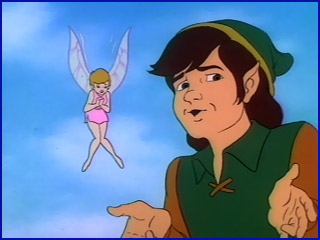
With the games themselves out of the way (and ignoring anything and everything on the CD-i), there’s no getting around the Super Mario Bros. Super Show‘s special Friday inclusion of the Zelda cartoon. Link suddenly became a snarky horn dog, far removed from the emotionless splash of pixels we had all become used to playing. The iconic, “Well excuuuuuuuuse ME, Princess!” ended up defining Link as a character for many fans for many years, probably up until around the time that more games came out to help wash away the memories (don’t get me wrong; I enjoyed the show!). It seemed like an all-too-obvious American, 1980s/1990s take on the character, and is certainly the most distinct of any incarnation.
Let’s jump over to Japan, though.
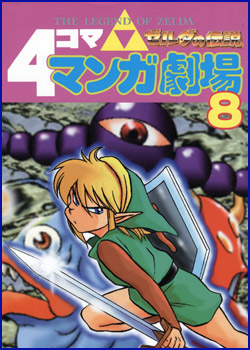
The first Zelda manga I ever picked up was actually a gift for Meri sometime shortly after 2000; it was one of the 4-koma comic series. For those unfamiliar, think of your typical American comic strip in a newspaper. The panels are the same size, run consecutively/chronologically, and tell a short (usually humorous) story. Series like Azumanga Daioh also were released in the 4-koma style. In this particular manga, there are a whole bunch of these very short (funny!) strips throughout the issue. Picking up bombs, finding hidden places… all the usual scenarios you would expect to play in a Zelda game are represented. While I cannot fluently read any of the text, the artwork is enough to get the hilarity across.

At Otakon 2007, one of the Japanese bookstores was unloading cheap copies of Akira Himekawa‘s manga, so I picked up two random volumes. These would be the versions that Viz would eventually bring out to the US about a year later. I didn’t do much other than flip through them, but I could tell that Link was at least talking with other characters and going about with his adventures almost exactly as we saw (and played) in the respective video games.
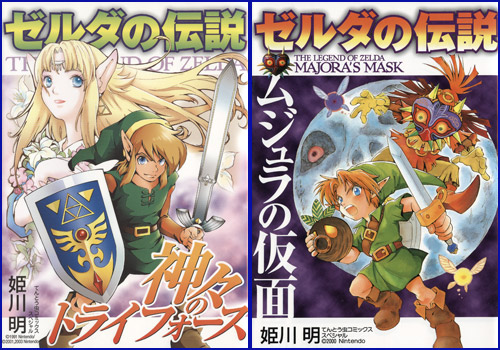
This takes us up to the American release of the manga, and the actual “review” of it (geeze, it seemed like it took a long time to get here!). With all of these “versions” of Link in mind, it was tough to jump into this and figure out how to accept him as a character. Add to that the fact that Viz brought it out under the “Viz Kids” label, and as a guy in his mid/late-20s, you start really wondering how or why you should read it at all.
Yes, there will be “spoilers” in this review (both for the original story from the game, as well as new plot points added to this manga).
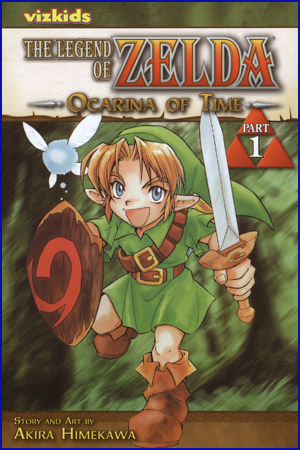
Since this particular manga tells the story of Ocarina of Time, I found myself assuming the role of that Link in my head, and I did so pretty easily. I knew where the story was going and how it was going to get there, but also knew that some plot points may be different.
It was a little tough to get used to a character that was so verbose, especially since Ocarina of Time (the video game this manga is based on) really solidified the “mute” Link. He clearly has “conversations” in the game, but you only ever get the OTHER characters’ side of it. Instead, the manga presents us with a character not afraid to show emotion both with his body and his voice, and even has plenty of internal monologue moments. It makes sense, and most likely wouldn’t work too well as a manga without these traits (though I’m sure plenty of doujinshi have explored this).
The story had enough nods to exact scenes from the video game to satisfy that itch, but also presented enough new plot points and character development to make me want to read it rather than just go play the game for myself, instead.
Things directly from the game that I liked included Saria waiting for Link by the bridge on the outskirts of the forest, carrying Princess Ruto around for a while inside Jabu-Jabu, and shooting an arrow into the painting to fight against the ghost/spirit version of Ganondorf.
Some of the new elements are what really help the story shine, though. The Stalfos that gets personified as something more than just a random, nameless bad-guy (it meets and battles Link both in the past and future) was a nice touch. One of the most heart-breaking parts of the manga was Link’s little dragon friend that was corrupted into an evil beast, which Link was forced to behead and kill in order to save the Gorons.
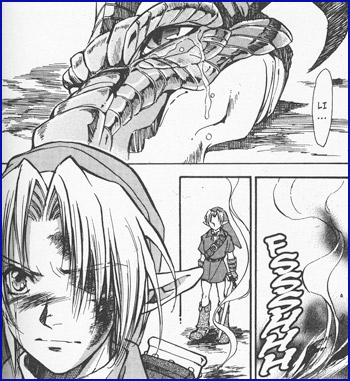
Even with a couple of these more “intense” story moments, they are not enough to bring the entire package to anything more than standard kids fare (and at times, maybe a little too childish). The Zelda franchise wouldn’t attempt to show its slightly darker side until Twilight Princess (though I’d argue that the Nightmares in Link’s Awakening did it first), so while it does make sense to have this particular manga be so heavy on the children focus, it might partially alienate the fans that have grown up with the series looking to jump into the manga. Sure, the manga is eight years old at this point, but I don’t see myself having too different an opinion on these elements eight years ago, either.
At the same time, what else should I expect? Nothing, really. I expected a children’s manga, and that is exactly what I got. Perhaps I was hoping for a couple extra bits here and there that might be more “adult” in tone, but it was not meant to be. That being said, I don’t mean to diminish what is actually presented and done well, which is the vast majority of what I’ve read.
I found the artwork a little busy and confusing at times (I had the same thoughts recited back to me by Meri, so I know I’m not alone). The logical flow didn’t always seem so logical, and the fading of edges and spreads could be misleading. The art seems to be very shoujo in style with trends of shounen story development (and with “Akira Himekawa” actually being a pen name for “A. Honda” and “S. Nagano” [both women], and the Zelda series also having a strong female fanbase, this makes a lot of sense).
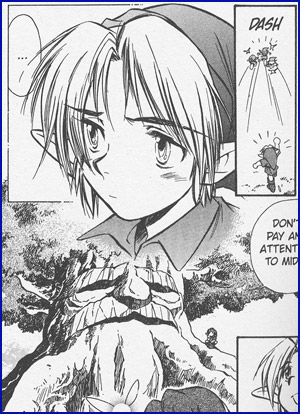
One thing that made my inner-nerd rise up in protest (both figuratively and literally, in that I couldn’t resist pointing it out to Meri) was the note on one of the in-between-chapter pages showcasing Link on top of Epona which says, “It’s unusual for him to hold his sword in his left hand.” Sorry, ladies! Link has exclusively been left-handed throughout his entire history, and wouldn’t be shown holding a sword in his right hand until the Wii version of Twilight Princess at least six years after this manga’s publication! Sure, it’s just a minor thing, but if they were going to make such an obvious note of it, that note should not be so glaringly incorrect!
One important “defect” with this particular Viz version of the release is the misalignment and binding of some of the pages (mostly toward the middle and later on in the volume). It seems to have been placed too far into the middle of the book, rendering the ends of some sentences completely unreadable. Hopefully this is fixed in future printings (this particular version I own is the first printing from October 2008).
While I have only gotten around to reading the first volume of the Ocarina of Time series (of two total), I look forward to grabbing the second volume and all subsequent releases (hopefully Majora’s Mask, etc.). Volumes one and two are available now from Viz under the “Viz Kids” label for $7.99 a pop. It’s a nice way for me to quickly re-experience games that I enjoy in theory, but can just never fully get into when I sit down to play.


Interesting that you can’t get into the 3D Zelda. Very nice review as well. i was thinking about buying this blind a few months back for sheer novelty, but I’m glad I didn’t! It’d be interesting to have some anime or video game manga adaptations that weren’t just cheap cash ins.i haven’t found any of merit at least.
Oh man, Zelda manga… I remember reading a fan translation years ago.
I’m DEFINITELY gonna pick this up when I get the chance. Thanks for reviewing it! 🙂
Great work, Mike! I am very interested in picking this up. Do you think you could do more reviews of this kind?
I had the same problem with the text being too close to the inside of the book. There were a few times I felt like I was going to rip the manga in half when trying to spread the pages far enough to read what someone was saying.
Where’s this page that says “It’s unusual for him to hold his sword in his left hand.” I found one with Link on Epona holding his sword in his right hand, but all it says is “This rough sketch was drawn before the series began.”
Also, Majora’s Mask delved into darker themes six years before Twilight Princess did, and arguably better as well.
Wow, thanks a ton for posting this review. I had just about completely forgotten that they were bring this manga to the states! I definitly have to pick it up (big time Zelda fan here).
I don’t have a lot to say other than that it’s pretty interesting how they made Volvagia into a friend of Links and then him needing to kill it. That was always one of my favorite bosses from the game and it’s cool that they gave him(her?) a back story other than, “It ate Gorons so a long time ago a Goron clubbed it with this here hammer and now it’s back again”.
I can’t wait to see how the Ganondorf/Ganon fights play out in the manga *wonders if Ganon still gets his face sliced up and then the Master Sword plundged into it*.
Gah! Edit button wont work. Can’t…fix…typos.
*sorry for double post*